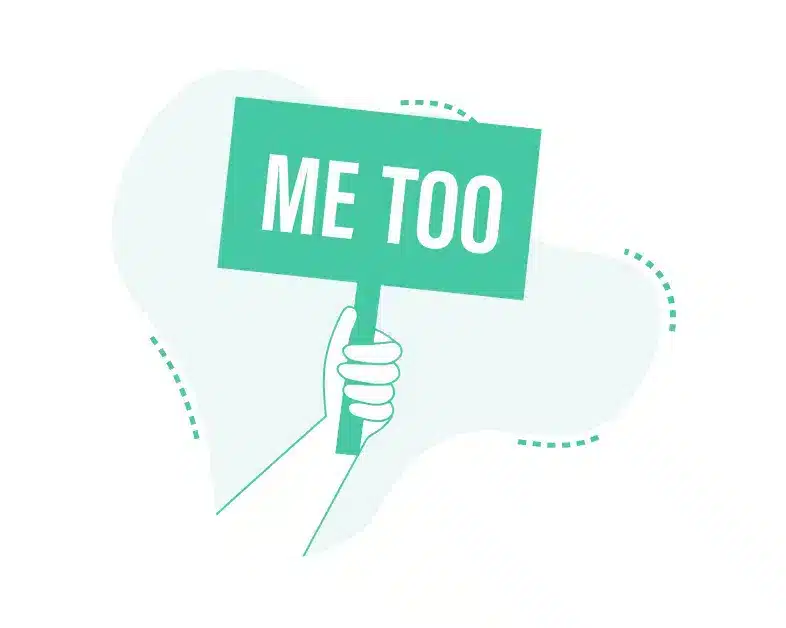That’s a fierce headline.
But nevertheless, it is the apparent truth.
And that leaves a certain surprise (and fright) because is it really THAT widespread in Danish workplaces?
So, our surveys (which so far count 420,980 pieces) show an unequivocal answer – that the offending acts actually occur, and that they occur much more often than we had just predicted.
It can be a difficult thing to track and discover as a manager, as the actions often take place in secret – or indirectly.
Therefore, it is extremely important that you go through the APV and follow-up well-being measurements, so that the problems are highlighted – and you thus have a chance to act proactively on these.
Abusive behavior spoils the working environment in general and makes a big dent in employees’ well-being.
In fact, stress sick leave and resignations are often caused by abusive actions that have been going on for a long period of time.
What are abusive acts?
Offensive acts are only the general term.
In reality, the actions must be divided into three categories:
– Bullying
– Sexual harassment
– Violence
Let’s go deeper into the categories.
Bullying – the source of sick days
Bullying is an abusive act that has serious consequences for those it affects.
Bullying is therefore not acceptable and requires knowledge, dialogue and preventive action to overcome the problem.
But bullying in the workplace does not only affect the individual – bullying also affects the working environment and can lead to lower productivity and sick leave. According to studies, bullied employees have 50-60% more sick days than others.
What is bullying?
Bullying is not just a simple argument or a form of disagreement between two parties.
Bullying is an abusive act that takes place repeatedly over a long period of time.
The Danish Working Environment Authority defines bullying as:
“It is bullying when one or more people regularly and over a long period of time – or repeatedly in a gross way – exposes one or more other people to abusive actions that the person concerned perceives as hurtful or degrading.”
Then we have the definition in place.
And yet there are several gray areas. Because it will always be the subjective perception of the situation and the relationship that determines whether it is bullying.
And it is difficult.
Because people are different and we have very different limits.
What is purely sarcastic humor to the receptionist can be offensive behavior to the cleaning manager.
The Danish Working Environment Authority therefore attaches great importance to the quantity – i.e. how large a volume these actions constitute – how often they actually occur.
Isolated situations will rarely be categorized as bullying – depending on the severity of course.
Examples of workplace bullying could be:
– Spreading rumours
– That you consistently talk down to an employee
– That you deliberately give an employee a very large amount of work compared to the other employees
– Exclude an employee from social events
– When an employee consistently undermines their manager’s authority
– Posting humiliating, offensive and threatening comments or images on social media
So yes, bullying can come in many guises and none of them are particularly fun for the recipient or for well-being in general.
Sexual harassment
There was a significant shift in the world in October 2017.
It was here that the MeToo campaign started and there was an unusual amount of focus on sexual harassment throughout the world.

Not that the sexual harassment became more extensive in that way, but the awareness surrounding it increased tremendously – and it began to dawn on many people what sexual abuse really is and how widespread it really is.
The statistics show that 11-12% of young women report experiencing sexual harassment every year.
And it is primarily women between the ages of 18 and 34.
Sexual harassment is defined as ‘any form of unwanted sexual attention’.
And again, this is a very subjective topic as we all have different limits.
Having said that, sexual harassment can occur in many guises and in many different scenarios.
– It can be between an employee and a customer/citizen.
– It can be internal between employees.
– And then, in particular, it can also be between manager and employee.
If the scenario is internal to the workplace, then a distinction is made between four different situations:
– Sexual harassment as punishment for breaking norms
– Sexual harassment as group culture
– Sexual harassment after the breakup of a romantic relationship
– Interplay that is misunderstood
Regardless of the situation in the workplace in question, it is extremely important that you, as a witness to harassment, act on it.
Still, there are an incredible number of people who take on the role of passive witness. And they do it because:
– They are afraid that it will affect themselves if they intervene
– They think that the person who is being violated is up to it
– They have a close relationship with the offender
– Sexual harassment is normalized in a group
– Violating gives status in a group
That is why it is so indescribably important that you act proactively and prevent a working environment that is characterized by being abusive. As soon as such behavior is normalized, there is a long and tough job of well-being ahead.
Investigate the cases with a Health and Safety Assessment, engagement survey or a pulse measurement. In this way, you gain concrete knowledge about the underlying (and hidden) problems that may exist in the working environment.
Be ahead of the curve!
Come to your senses and draw up a clear policy for what is allowed and how you would like the employees to behave and treat each other.
The most important step here is to clarify the company’s values and culture – and as the first step pass these on to new employees.
New employees are the strongest card in relation to changing the work culture from within. If they come in with a deep understanding of where the various boundaries are with you, then there is minimal risk that they will be affected by an already unsuitable environment.
This does not mean that employees who have been with the company for a long time should not be worked with.
Here you use the results from the measurements to locate the problems – and from there prepare action plans which ensure that everyone becomes aware of how you would like employees to treat each other.
You should encourage dialogue.
Dialogue is the absolute strongest card in relation to subjective issues. Dress employees up to dare to speak up and be open about where their limits lie.
Violence – in physical and psychological form
The European Commission defines violence as follows:
“Situations where a person is slandered/humiliated, threatened or assaulted in connection with the performance of work, where the slander/humiliation, threat or assault contains an explicit or implicit attack on the individual’s safety, well-being or health.”
And from here one distinguishes between two types of violence:
- The physical violence
- Psychological violence (threats of violence)
Violence can also be differentiated in relation to whether it is committed between an employee and a customer/citizen or whether it takes place internally between two employees. It can also be between manager and employee.
Physical violence
Physical violence is a direct attack on the body – e.g. push, punch, leg brace, restraint, throwing objects, assault, attempted suffocation or stabbing.
Psychological violence
Psychological violence is threats of violence – ranging from threats to your own life to threats concerning family, friends or the employee’s belongings.
Threats can also be real without words – eg the movement of a finger across the throat or a clenched fist.
Psychological violence and threats of violence can also happen via social media, SMS and email.
Are you an employer? – Remember your responsibility!
Everyone in the workplace plays an important role when it comes to identifying, dealing with and preventing violence.
But it is the employer’s duty to prevent work-related violence and to set a framework for how cooperation on the prevention of violence at work should take place.
In addition, it is your duty as an employer to report the violence to the Danish Working Environment Authority and the Danish Working Injuries Agency via EASY.
Where is the limit?
Yes, it is a completely subjective question.
Because, as mentioned, we are different – and thus have different limits.
But here is a VERY important rule to remember:
Trust what you experience yourself!

If YOU experience a situation as unpleasant, transgressive and offensive – well, then the situation IS exactly that!
And yes, it can be unmannerly difficult to speak up in the moment and trust your own feelings. Because ‘Am I just overreacting?’ and ‘He probably didn’t mean anything by that!’ But only you can tell if your limit has been exceeded.
Then there is the eternal dilemma ‘Will there be a big conflict if I say no?’ – and it is completely natural to think like that.
Of course, the best thing would be if you can speak up immediately, so that the offending party can become aware of your boundaries immediately and you can start a dialogue about it. Much can be a definite misunderstanding – and it is best to get it clarified at an early stage.
But if the situation is so uncomfortable that you don’t feel comfortable in it, you also always have the option of going to your immediate manager or trade union representative.
Is it a one-off situation or a consistently abusive treatment that you are subjected to?
If it is the pervasive violation, then it is very important that you act on it NOW!
You don’t have to wait for a Health and Safety Assessment or an engagement measurement to ease your heart. There is NO shame in voicing your experiences. Maybe there are other colleagues who feel the same way as you.
Abusive behavior is pure poison for your working environment – and it is therefore important that it is acted upon immediately.
The long-term solution
Implementing a new behavior pattern and a new mindset in a company is difficult and lengthy – but not impossible.
The process itself is really simple.
- Start with a Health and Safety Assessment or an engagement survey
- Analyze the results and map the problems
- Prepare and implement the action plans
- Run a power measurement after some time
And the most important parameter in this process (once you have been made aware of the problems) are the action plans.
They are your strongest tool towards better well-being and a better understanding between employees.
Use the action plans to start the dialogue about the employees’ personal boundaries and the usual communication.
We are human – and we can never, ever avoid stepping on each other’s toes.
It therefore gives a strong signal when you as a company show that you care about the well-being and well-being of your employees in everyday life.
And it pays off to the highest degree that you take care to prevent – so it is essential for your culture that offensive actions are not allowed.
Get inspiration via the Danish Working Environment Authority’s dialog cards – find them here >>> ww.hergårgræsen.dk
So what does the Danish Working Environment Authority do?
You can complain to the Danish Working Environment Authority if you or others in the workplace are exposed to offensive actions by other employees or managers.
The Danish Working Environment Authority can intervene if employees or managers rudely or repeatedly expose one or more people to offensive actions that those involved perceive as degrading and risk becoming ill.
You must be prepared that such a complaint may result in the Danish Working Environment Authority visiting the company.
Here they will try to assess whether the company violates the working environment regulations.
If the complainant has chosen to remain anonymous (which you always have the right to), then the Danish Working Environment Authority can only assess the company based on the physical visit – and must not mention the complaint itself and the reason for their visit.
It is also a prerequisite for the Danish Working Environment Authority’s assessment that the offending employee/manager is still employed by the company when the episode(s) is reported.
Who can complain?
Anyone can complain to the Danish Working Environment Authority about abusive actions.
You can complain if you yourself are subjected to offensive actions or if a colleague, a friend or a family member is subjected to either bullying, sexual harassment or violence.
Doctors, trade unions and the like can also complain on behalf of the victim.
Please be aware that a complaint/announcement does not necessarily entail a visit from the Danish Working Environment Authority. All complaints are handled and assessed – and if it is assessed that there is a basis for a closer investigation of the company, then the Danish Working Environment Authority will visit the company – without warning.
Offensive actions require action
When an employee is exposed to offensive actions, he/she will be in the danger zone for longer sick leave and, ultimately, outright dismissal.
It costs the company a lot of money on the bottom line, but most importantly, it poisons the working environment and well-being – and will eventually cause more employees to be affected. So make it a priority to prevent the offending acts and make sure you create a work culture that makes room for everyone and everyone’s limits.








